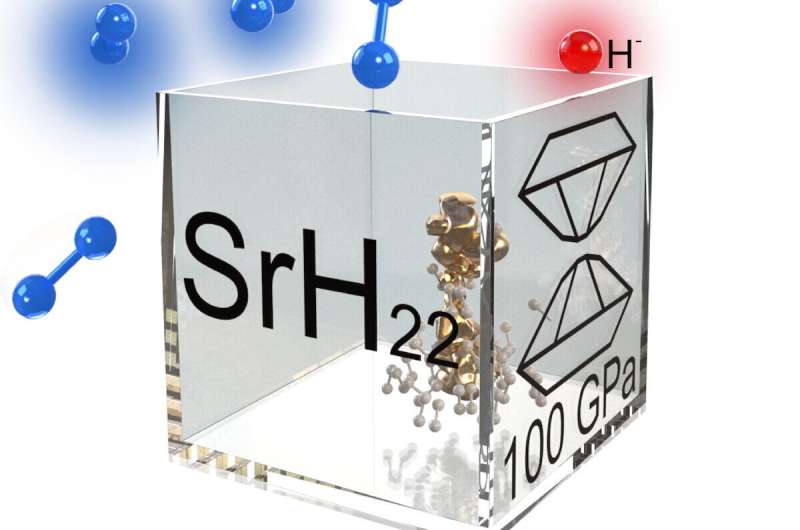Superionic compound with the highest hydrogen content successfully predicted and explored

In collaboration with scientists from Jilin University in China, a group of Skoltech researchers led by Professor Artem R. Oganov discovered a unique compound—strontium hydride SrH22. It has the highest hydrogen content known so far and is stable at pressures of 80–140 gigapascals (about a million atmospheres). The compound obtained has mobile hydrogens, capable of transporting charge.
The "hunt" for polyhydrides—compounds with high hydrogen content—started in 2015, when a group of scientists from Germany experimentally proved that at a pressure of 150 gigapascals, sulfur hydride H2S transforms into a new compound—sulfur trihydride H3S, which turned out to be a high-temperature superconductor, losing electrical resistance at a then-record temperature of 203 Kelvin (-70 degrees Celsius). This was a fairly significant increase in temperature compared to previously known superconductors.
"The ultimate goal of studying these 'strange' compounds is to determine the ones that are superconductive at near room temperature and at least high, or better yet, low pressure. Some of the best high-temperature superconductors known to date, such as YH6 and (La,Y)H10, have been studied in our laboratory, using the USPEX algorithm," says Skoltech Professor Artem R. Oganov, the creator of a one-of-a-kind algorithm for predicting crystal structures. For any combination of chemical elements, it determines what their compounds are stable and which structures they form.
In the new work, the scientists turned to strontium to see if it can form stable polyhydrides. The USPEX algorithm theoretically predicted that the stable compound SrH22 should exist at pressures of 80–140 GPa. A research group of professors Xiaoli Huang and Tian Cui from Jilin University conducted an experiment on the synthesis of strontium polyhydrides, doping molecular hydrogen with strontium, which means adding a small amount of this metal as an impurity. To confirm the formation of stable strontium polyhydride in the experiment, its crystal lattice was examined by X-ray diffraction analysis. The resulting pattern fully corresponded to the crystal structure of SrH22.
"Experiment and theory complement each other. The experimental approach based on X-ray diffraction cannot determine the spatial arrangement of hydrogen atoms. But theory can predict not only their location, but also the dynamics, charges and transport properties. In our study, we found that strontium atoms are arranged in a highly ordered manner, while hydrogen atoms are 'smeared out' in space, constantly moving, and in general act more like liquid," says Skoltech Ph.D. student, the first author of the article, Dmitrii Semenok.
The experimentally confirmed strontium polyhydride SrH22, the hydrogen-richest compound known to date, consists of H2 molecules distributed around a highly organized strontium sublattice. Moreover, the high mobility of hydrogen makes SrH22 a good ionic conductor, opening up the possibility of using it for electrochemical transformations at high pressure. This will make it possible to obtain new valuable polyhydrides that cannot be synthesized directly from metals and hydrogen. Another possible application of this discovery is the design of new compounds for hydrogen batteries.
"One can imagine that we have a box of Lego parts, we dig into them and try to figure out which parts will suit our needs. We found out that the elements of the second and third groups of the Periodic Table are most favorable for the formation of high-temperature superconductors. Strontium is one of them, but now we see that in its pure form, it is not quite suitable. Yet, its hydrides are very interesting from the chemical viewpoint, and if doped with other metals with more electrons—yttrium, zirconium, titanium—it may be possible to obtain high-temperature superconductivity. So, we studied the corresponding 'Lego piece' and realized that it does not fit by itself, but if combined with some other, it might work," Oganov explains.
More information: Dmitrii V. Semenok et al, Sr‐Doped Superionic Hydrogen Glass: Synthesis and Properties of SrH 22, Advanced Materials (2022). DOI: 10.1002/adma.202200924
Journal information: Advanced Materials
Provided by Skolkovo Institute of Science and Technology





















